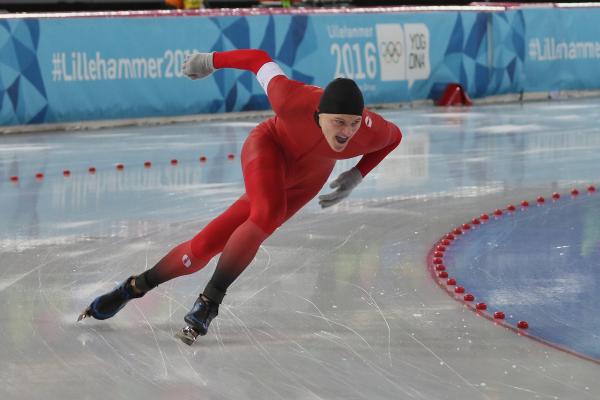At the expense of many ardent fans and true-believers in the world of speed skating, somebody, somewhere is having a pretty good laugh right about now.
This has to do with pulling a conceptual fast-one over those gullible enough to believe it. It's the floating of a false reality, rooted in a fact-starved, baseless premise that a color change can make athletes skate faster.
Yes, that's correct, the color of the bodysuits worn by skaters. Not that the suit is made from a better, more aerodynamic material in a different color. But that the color itself gives the skater an edge.
In a riveting yet impossibly-hard-to-believe article this week in the New York Times, representatives of several nations for the sport, most notably Norway and Germany, have been selling the idea that "blue color is faster than any other color." Observers, administrators of the sport, and even some skaters themselves are repeating these statements and rumors, and people are starting to believe this preposterousness.
"It's been proven that blue is faster than other colors," according to a sprint specialist for the Netherlands, Dai Dai Ntab, quoted by the Times, which provided no indication whatsoever that it was said with even a hint of sarcasm. "Every Olympic season, everybody is trying to find the hidden gem [that provides a competitive edge]. This year it's the blue suits."
Anyone not easily duped would have to believe that this craziness is being circulated with a wink and a nod, that it's really just an inside joke. But short of the idea that the Times is trafficking in satire, that's what the speed skating cognoscenti have decided to actually believe.
Welcome to the world of a sport that separates winning from losing in hundreds of a second, and the single-mindedness to do – or believe – just about anything to edge out the competition.
The focal point of this current ice escapade is Norway, which decked out its skaters at a pre-Olympic event in the country's town of Stavanger in skin-tight body suits featuring four hues of blue. For observers, this was a startling change, since they have become accustomed to always seeing the team clad in bright red (with the exception being the 2002 Olympics in Salt Lake City, when its members wore black and gray bodysuits).
“They said it skates a little faster than red, so I like to believe that,” said Norway's Hege Bokko last month after skating in an event in the blue uniform.
And it was just as startling given that Norway is no also-ran nation; a powerhouse in speed skating, it has won 80 Olympic medals since 1924, second-most all-time to the Netherlands, which has 105. To understand the magnitude of the change. it would be as if, as the Times' reporter Andrew Keh smartly wrote, "the Yankees had showed up at the baseball playoffs in polka dots rather than pinstripes."
Since logic dictates that a specific color itself cannot reduce drag and increase speed around the oval track, let's return to the original question: Why did Norway do this? Theories abound, but here are three that are possible.
First, Bokko (pictured, prior to the suit change) said she would like to believe that it works, so there's the psychological element. Self-confidence is an essential component in competition, so that could be it. Second, another skater observed that the color was similar to one used by one of the team's sponsors in its logo, so marketing could have prompted the switch.
And finally, when athletes square off face to face, inches from each other, if one can play mind games with its opponent, that gives that athlete an edge. If you can get your adversary to think, "What's that guy doing?" or anything to that effect, that takes his focus off the event and you acquire an advantage.
All are plausible but I have another theory.
Over the last five Olympics the Norwegian team has been dreadful. And this suit change might have been a coaching decision to wake everyone up, both men and women, and usher in a new era.
Prior to the 1998 Olympics in Nagano, Japan, Norway had won 76 medals, making it #1 in the world.

Since then, in the last five Games – as shown, at far right, in the 5 columns prior to the last listing the overall medals total – Norway has won a total of 4. Yes, just 4.
Over that same period the Netherlands, wearing orange and black suits, has captured 58 medals and has blazed past Norway. That includes the Dutch, as the medal board shows, completely wiping out the Norwegians in the 2014 Games in Sochi, Russia ... by a count of 23 to zero.
Choosing a "faster color" or doing something – anything – to change Norway's luck. To explain the color switch, which one do you think looks more plausible?




